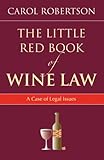Carole Robertson. The Little Red Book of Wine Law: A Case of Legal Issues, (ABA Press, 2008). ISBN: 9781590319888
 I’ll admit that when The Little Red Book of Wine Law first crossed my desk, I thought it must have been essentially a vanity project, inexplicably subsidized by the ABA Press, that was conceived of in order to provide the author a way to write off vineyard trips as business expenses on her taxes. I cannot tell you how delighted I was to discover that I was mistaken. This slim (only 163 pages) volume provides an engaging and accessible introduction to American wine law and history that will broaden the reader’s appreciation of the wine industry. Though short and non-technical, this book is suitable for a surprising number of library collections.
I’ll admit that when The Little Red Book of Wine Law first crossed my desk, I thought it must have been essentially a vanity project, inexplicably subsidized by the ABA Press, that was conceived of in order to provide the author a way to write off vineyard trips as business expenses on her taxes. I cannot tell you how delighted I was to discover that I was mistaken. This slim (only 163 pages) volume provides an engaging and accessible introduction to American wine law and history that will broaden the reader’s appreciation of the wine industry. Though short and non-technical, this book is suitable for a surprising number of library collections.
Carol Robertson introduces the book with a brief, anecdotal history of wine in America and how successive waves of explorers, immigrants and other populations have lent their influence to the wine cultivation and culture which we have today. This history — which touches upon figures such as Leif Erikson, Fr. Junipero Serra, Thomas Jefferson, Agostan Haraszthy and the Mondavi family — paints an interesting portrait of the changing tastes and demographics of the United States.
Each chapter reviews one of twelve pivotal cases dealing with wine or vineyards. Though the twelve cases cover diverse topics such as intellectual property, antitrust, labor law and international law they always cover these topics through the lens of wine — namely, the sale and production of wine. The case summary and descriptions are lucid and engaging, providing the reader with the legal, historical and social background of the case at hand. These chapters are arranged in a rough chronological order by the case dealt with in each chapter. Even though the cases date back to 1910, Robertson goes out of her way to explain how each one has left its mark in the current American wine industry.
Though the twelve cases form the organizational foundation of the book, this is not, at heart, a casebook, and the author always refocuses the discussion on wine. Instrumental to this goal are the vignettes which appear in each chapter. These vignettes discuss wine-related concepts, history and populations. I did find the information in some of the vignettes a bit repetitive. I have mixed feelings about this. On the one hand, an excess of thoroughness is hardly a sin (especially to a librarian). On the other hand, repetitiveness in such a slim, non-technical volume seems unnecessarily verbose. I suppose ultimately, this will come down to a matter of personal tolerance and preference.
Overall, this book is perfectly suited to any lawyer who works in or for the wine industry, or who is a wine enthusiast. However the book’s style of writing, engaging as it is, is generally more suited to such personal collections than it is to legal academia. That being said, there are very few up-to-date resources that cover American wine law, outside of CLE publications put out by the various state bar associations. Given that situation, I believe this book would find a welcome home in any academic library collection that supports a viticulture program, in the libraries of law schools at which wine law is taught. Further, the style of writing is accessible enough that the book would be welcome in the collection of any library with a patron base that is interested in wine or vineyards.

| The Little Red Book of Wine Law: A Case of Legal Issues Author: Carol Robertson Binding: Paperback List price: $19.95 Amazon price: $18.20 |
